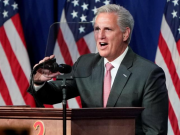China has set the growth target in the range of 6.5 percent-7 percent for 2016, after the world's second largest economy slumped to the weakest growth in 25 years last year.
China's National People's Congress approved the target figures, which will be officially announced by Prime Minister Li Keqiang later.
The annual party congress, which is tasked with steering the economic and political agenda for the communist government, assumed greater significance this year as the government fights multiple laggards in the economy.
China is facing a backlash from its industrial overcapacity and is poised to cut millions of jobs, potentially triggering a social unrest.
The country's stock markets witnessed a massive crash in recent months, losing more than 30 percent of the value, while a large scale government intervention to prop it up only returning partial results.
The world's second largest economy expanded 6.9 percent in 2015, while growth in the fourth quarter was 6.8 percent, the slowest quarterly GDP growth since the global recession in 2009.
The latest reports show that China is planning to lay off up to six million state workers in order to reduce industrial overcapacity and cut down the workforce in bloated 'zombie' industries.
The country's minister for human resources had confirmed that the government will lay off 1.8 million workers in the coal and steel industries.
Earlier this month, state news agency Xinhua reported that China plans to close 4,300 coal mines and remove outdated production capacity of 700 million tonnes and relocate 1 million employees.
Ratings agency Moody's downgraded its outlook for China from "stable" to "negative, citing the country's declining fiscal health.
"Without credible and efficient reforms, China's GDP growth would slow more markedly as a high debt burden dampens business investment and demographics turn increasingly unfavourable. Government debt would increase more sharply than we currently expect," Moody's said.









